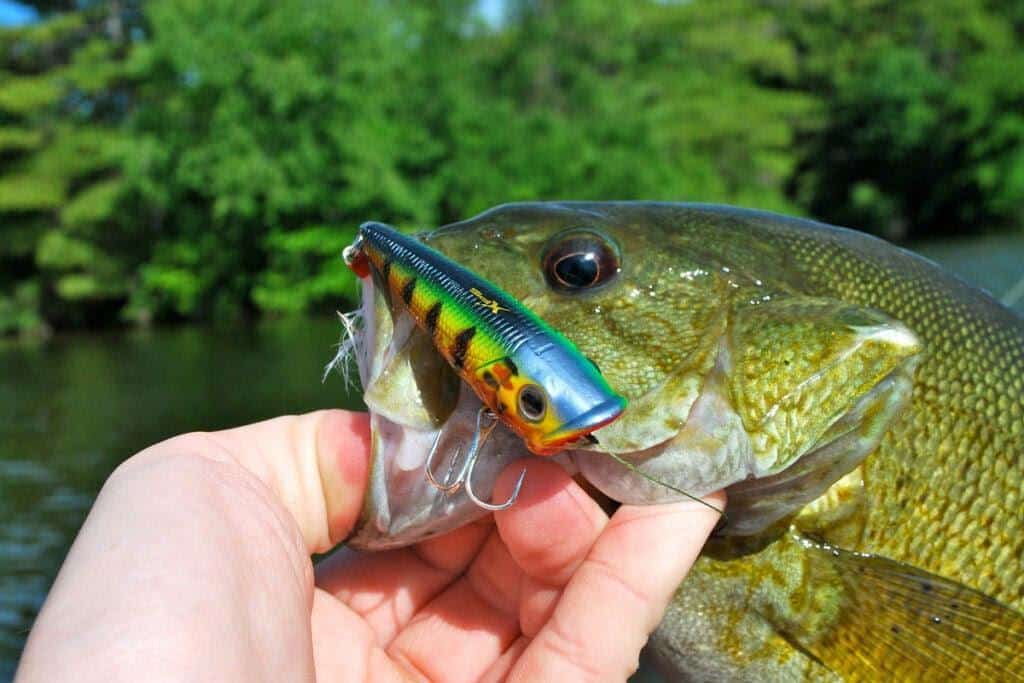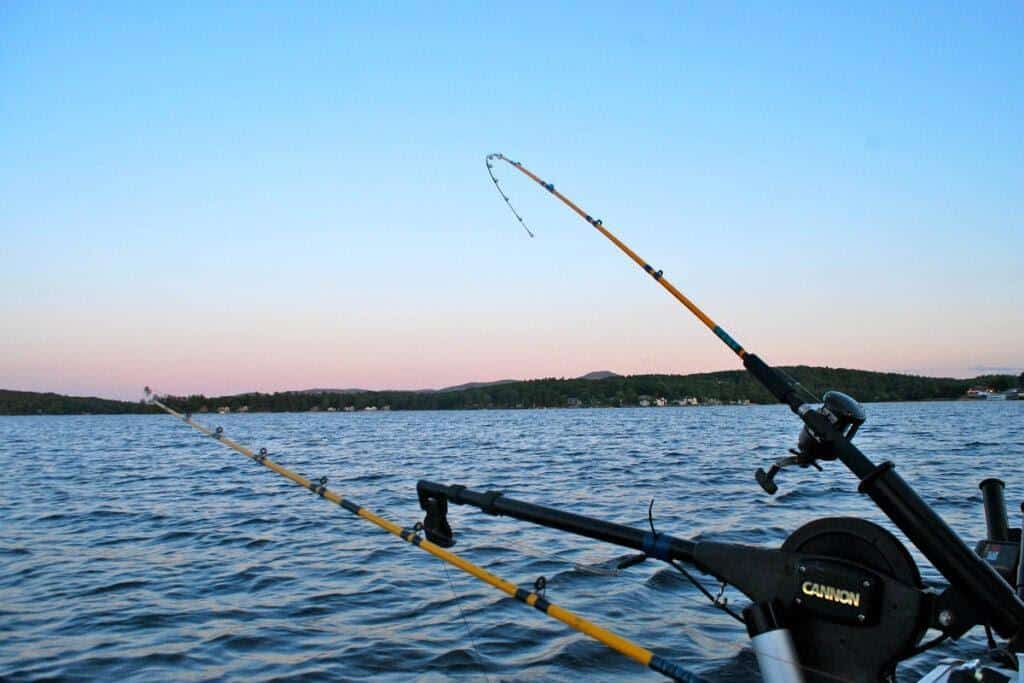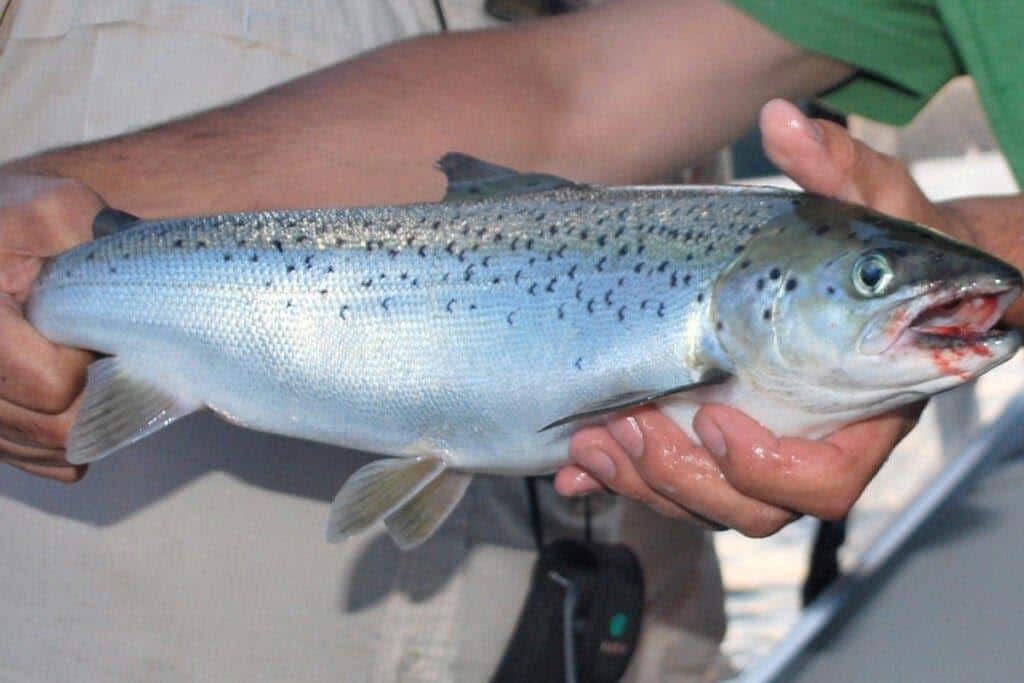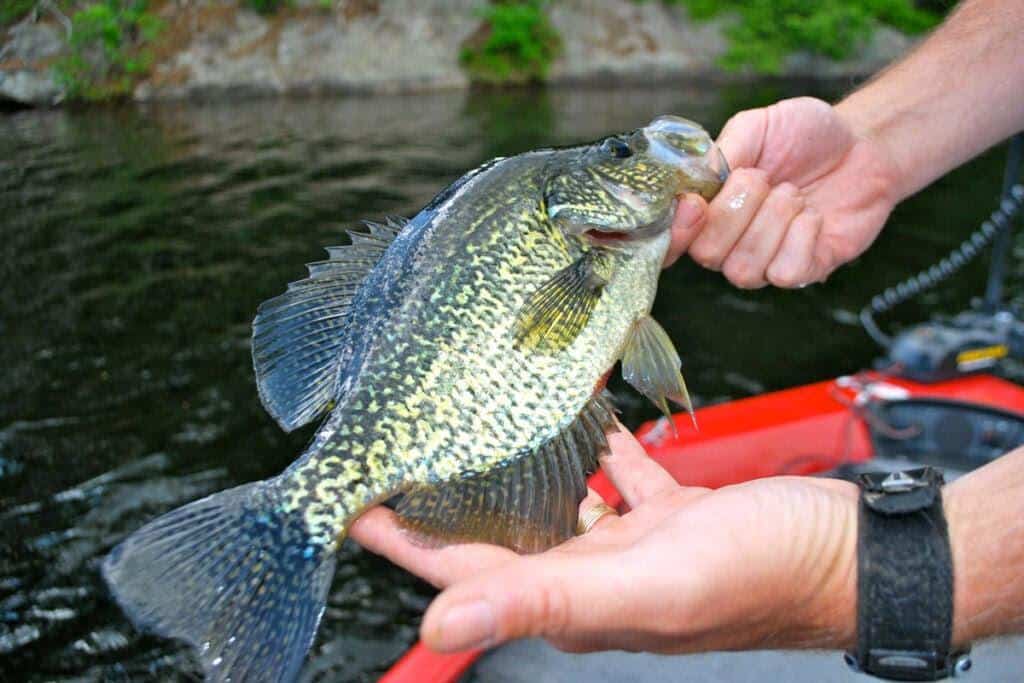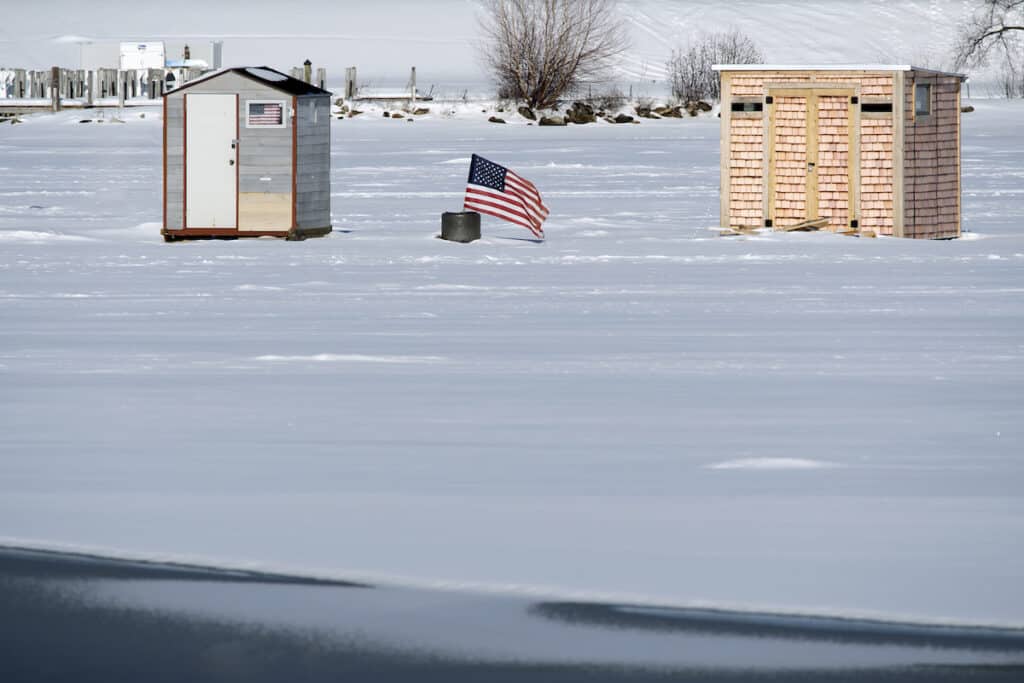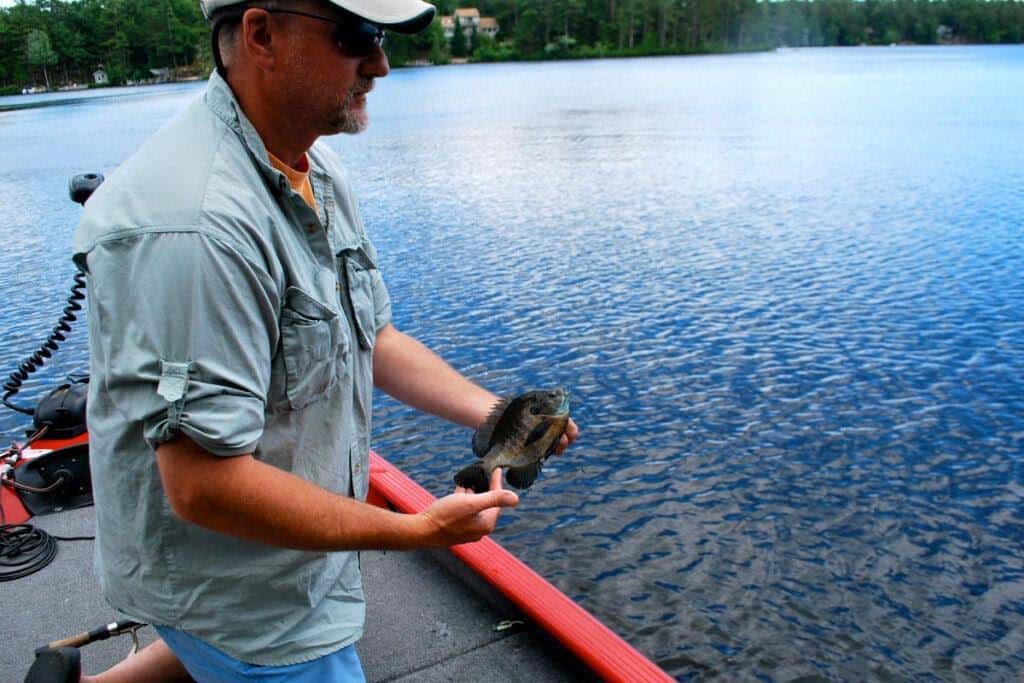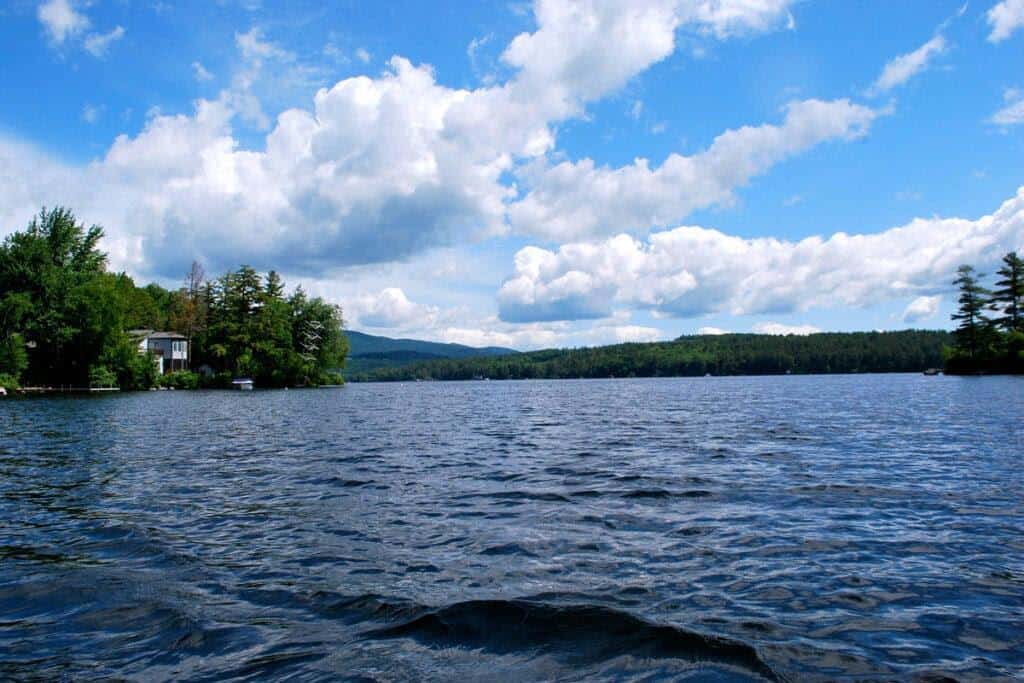With 365 islands punctuating 600 billion gallons of water, and more game fish than we could put a number to, “Lake Winni” is one of the most productive, beautiful, and heavily fished bodies of water in the Northeast.
Here you can catch smallmouth and largemouth bass, lake trout and rainbow trout, crappie, cusk, perch, and a host of other species.
Lake Winnipesaukee is such a gigantic and diverse water body with such variety that we’re going to go species by species to help you have your best days possible on Winni this year.
To help in this enormous task, we talked to an expert: Mark Beauchesne has not only been a key official with the New Hampshire Fish and Game Department and also operates his own part-time fishing guide service.
Lake Winnipesaukee Bass Fishing
As a guide, one of Beauchesne’s key roles is putting his clients on giant bass.
“The northern end of the lake warms the quickest,” Beauchesne explained.
To find that area on a map, look at the portion of the lake near Multonborough and Center Harbor.
He said the jerkbait bite, for Lake Winnipesaukee smallmouth bass specifically, can be incredible in the spring months of May and early June.
And while the latest Garmin fishfinder with side-imaging certainly can’t hurt your chances of finding fish, Beauchesne said there’s a simpler way.
“New Hampshire has a very unique navigational system,” he explained. “We have navigational markers where hazards are. There are some places where you might be running a boat fine for half a mile in deep water, and all of a sudden, there’s a shoal.
“You can have a spot where on one side of the boat it’s 26 feet deep, and on the other side it’s 6 feet deep.”
“If I’m spring-time, pre-spawn fishing, I’ll position my boat on those shoals, marked by the buoys, and cast into deeper water, and reel back,” Beauchesne said.
It’s helpful to know that in the winter months, smallmouth bass will find the deepest holes on the lake where water temperatures are the most stable and then move up to shallower areas as the water warms.
To take advantage of that seasonal pattern, try Beauchesne’s simple recipe for success.
Spring
Of course, spring is spawning time for both largemouth and smallmouth bass. Beauchesne said that the water on Winnipesaukee can be so clear that you can spot the beds as far as 50 yards away.
Beauchesne said bass typically create their beds in depths of 2 to 12 feet.
Because you can legally fish for black bass all year in New Hampshire, albeit with a no-harvest period from May 15 to June 15, finding fish on beds can be a very effective and visual way to catch and release both largemouth and smallmouth bass in the spring.
“They still have to eat,” Beauchesne said. “I’ll watch and watch and watch, and if I see them guarding or working a bed … keep an eye on them to see if they’ll leave to go eat an insect, or whatever it might be.”
By patterning fish behavior before fishing, he can make a more informed approach.
The timing of the spawn can all depend on the weather, but typically mid-May is a good time to start keeping an eye out for those beds. Water temperature is a more accurate predictor.
“They’ll move up at 55 or 56 degrees … and start sweeping beds,” he said.
He did add that a cold snap, especially a prolonged one, can move fish off their beds and back into deeper water. But any time that water temperature tops 50 degrees, it’s time to keep an eye out for shallow-water bass.
Summer
As spring warms into summer, the bass will complete the spawn and move to deeper parts of the lake, looking for cooler and more consistent water temperatures.
“Once we get into late-June, July, target them around basin edges, the edges where you’ve got nearby deeper areas,” Beauchesne said.
The guide’s choice of lures for the warmest months of New Hampshire won’t surprise anyone.
“Drop-shotting and throwing Ned rigs have both been really effective methods,” he said, echoing a sentiment bass anglers all over the country are discovering at a blistering pace.
The essential characteristic of both the drop-shot and the Ned rig is that you are suspending a bait either at or just off the bottom, where a lot of bass are holding or foraging during the summer.
The flat head on the jighead of a Ned Rig is essential because you want that bait, whether it’s a Senko-style worm, crayfish, or creature bait, to stand straight up and down and “hop” across the bottom rather than to lie flat and drag.
When drop-shotting, you’re putting a bait right in the strike zone where it becomes borderline irresistible to bass holding just off the bottom.
Fall
When the fall comes around, bass “start that pattern over again in reverse,” Beauchesne said. However, the deep-to-shallow movement of schools of largemouth and smallmouth all happens faster in the fall than in the summer.
While it varies year to year, Beauchesne considers Columbus Day weekend a good time to start looking for bass feeding in Lake Winnipesaukee’s shallower water.
He said that blade baits in particular, like the Bass Pro Shops XPS Lazer Blade or the Cabela’s MeanEye Blade Baits, can be deadly in September and October.
Beauchesne typically sees bass moving into depths between 30 and 40 feet in the fall months to feed. Targeting those basin areas once the leaves are in full color can be your most effective bet.
Winter
As the fall gives way to the legendary, long New England winters, bass move to what many anglers call wintering holes.
These are the deepest parts of Lake Winnipesaukee, where the water temperature is the most stable. Bass ride out the months of December through February, and sometimes part of March, in these deep holes.
A good topographic lake map and reliable depth finder with an ice-fishing transducer (ice-ducer) are essential to finding bass when ice fishing. Target the deepest holes in the lake.
Quite often, the same lures that were effective in the warm-water season can work through the ice if they allow a vertical presentation. For example, blade baits are a popular ice-fishing option. Rapala Jigging Raps are a largemouth and smallmouth favorite, and live bait rarely fails through the ice.
The south and south-central portions of Lake Winnipesaukee have some especially deep holes and basins, pushing 100-plus feet in many places. These are worth exploring when fishing for bass in the winter months.
Deep parts of the lake near shallow flats are the ideal combination. Bass may come out of their wintering holes to pin bait on a nearby flat, but they’ll want to hunt close to that deeper hole.
Mimic the Forage
Beauchesne said there’s no shortage of forage in Lake Winnipesaukee, and as with any fishery, mimicking what they’re eating can be incredibly effective.
He noted that white perch are common in Lake Winnipesaukee, providing a fishery all their own but also important information for bass seekers.
The fry of those white perch are among the favorite meals of a number of the game fish, bass among them. So look at a white perch fry in a Google image search and match your blade bait, jigging rap, or stickbait choice to that color pattern for optimal effectiveness.
Lake Winnipesaukee Trout Fishing
Lake Winnipesaukee is best known for lake trout, the largest member of the inland trout and char family in New England.
The lake also is stocked with rainbow trout and has a few Eastern brook trout.
Lake Trout
If you want to catch a big freshwater fish in New England, it’s tough to top lake trout. In fact, lake trout are the biggest fish in Lake Winnepesaukee.
New Hampshire’s record for the species is 37.5 pounds, although it came out of Big Diamond Pond not many seasons ago.
We won’t speculate if any nearly 40-pound lakers are swimming in Winnipesaukee, although we wouldn’t be surprised. However, anglers land double-digit lake trout every year. We don’t expect this year to be an exception.
When it comes to lake trout, two primary fishing methods will give you your most effective shot when targeting these fish: jigging and trolling.
Spring
In the spring, lake trout often spread out, prowling around drop-offs and submerged structure, following schools of perch or rainbow smelt.
Because the fish are less concentrated than they typically get in the summer and winter, trolling can be the most effective method.
Lures like Mooselook Wobblers, Lake Clear Wobblers, and a variety of spoons and minnow plugs can all be effective for early-season lake trout.
Deep-diving crankbaits like a Rapala Shad Rap are a Winnipesaukee favorite for good reason. Both the Rapala Shad Dancer and Scatter Rap can be great trolling choices for lake trout. The size 7, 8 and 9 shad raps specifically are great laker baits.
One suggestion that can make a difference is to troll two crankbaits simultaneously, one with a wide, irregular wobble and one with a tighter action. Then, when one gets the hits, switch both to the crank they want that day.
Summer
The summer months, particularly July, August and the beginning of September, often make lake trout the easiest to find in Lake Winnipesaukee. With lake temperatures at seasonal highs, lake trout often hold between 75 and 150 feet or deeper.
One of the most popular methods of fishing for lake trout this deep in the summer is vertical jigging, a method whereby you’re fishing a large jig straight beneath the boat or kayak.
Look for jigs at least a half-ounce, assuring they’ll get down to those depths rather quickly. Try to mimic the pattern of the rainbow smelt on the lakers’ menu at Winnipesaukee.
Varying your retrieve style and speed can be an effective means of finding what these fish will eat, but the most crucial part of a lake trout angler’s summer toolbox will be a quality depth finder.
You’ll want to look for large schools of bait. When you mark these larger schools, you’re apt to see lakers not far behind.
Vertical jigging near larger schools of bait can be an incredibly effective method for summer lakers. The steeper the vertical drop near a given location, the more likely it is to hold both schools of bait and lake trout.
Jigging Raps, jigging spoons, or soft-plastic swimbaits on heavier jigheads can all be effective means of getting deep. Color choices that mimic the predominant forage, either rainbow smelt or yellow perch, are a good decision.
Fall
Water temperature can be a key to finding lake trout as they change locations throughout the seasons. You will often find lakers and their forage in water temperatures between 45 and 55 degrees.
That colder water is often only near the bottom in the summer, but shallower depths begin to cool down as August turns to September. While lake trout can survive in water as warm as 60 degrees, they won’t stay there long.
It’s important to note, however, that it is illegal to target lake trout after September 30 in New Hampshire.
Winter
Beginning January 1, you can legally target lake trout through the ice. And you’d be hard-pressed to find a larger fish you can catch on an ice rod in New England.
With some exceptions, Lake Winnipesaukee’s wintertime lake trout will typically be in water depths between 20 and 70 feet because the smelt they’re eating will be there too.
So, it’s a good idea to study a topographic map of the lake, find basins in that depth range, and start there. At times, though, you may need to move around and outside that range.
Another key to finding lake trout will be locating deeper areas with shallow coves or bays near them. Lake trout will come up from the depths to hunt on these flats before returning to their winter holes.
Jigging raps, jigging spoons, and of course, live bait will all catch trout.
If you’re not marking or catching fish in flat basins in that depth range, concentrate your efforts around humps, coves or anywhere with sharp depth changes. Lake trout tend to hunt in these spots.
It’s always a good idea to be on the ice at first light and set as many tip-ups as you can keep an eye on (the limit is six on most waters), and be ready to run if you see a flag.
Having bait on a few tip-ups while working jigs or spoons with an ice rod and focusing your efforts around steep drop-offs will increase your chances enormously of putting a big laker on the ice.
Rainbow Trout
New Hampshire Fish and Game stocks Lake Winnipesaukee with year-old rainbow trout, usually near Alton at the southern end and Gilford at the northeast side.
Fishing will be best soon after the late May plantings, as hatchery rainbows may take awhile to spread out and acclimate.
Freshly stocked trout will bite natural and artificial baits, lures such as spinners and spoons, and artificial flies.
As they spread out and chase more natural food, trolling can be an effective way to catch rainbows.
Rainbows also will bit through the ice along with lake trout and other species.
Brook Trout
This native New Hampshire species is fairly uncommon in Lake Winnipesaukee, according to NH Fish & Game. Rare catches would most likely occur by anglers targeting other species in the lake.
Lake Winnipesaukee Salmon Fishing
Whether it’s their brilliant silver coloration or their potentially acrobatic fight, landlocked Atlantic salmon have been a Winnipesaukee favorite for decades.
Spring
Both smelt and shiners will produce landlocked salmon for the bait-fishing crowd in the spring when the season opens April 1.
Another fun way to target them is trolling. These fish are faster than many other species, so you can pick up the pace to attract their attention. Yo-Zuris, Rapalas, and spoons like the Mooselook Wobbler are all strong candidates for spring trolling.
At first ice-out, salmon often will be along the lake’s perimeter, in shallower water, so targeting them by trolling in these zones can be effective.
Trolling streamer flies on fly rods is a time-honored tradition for the region’s landlocked salmon anglers. There are any number of colorful streamer patterns that will attract spring salmon.
Pay attention not only to when the fish are hitting trolled lures but which one.
If you’re getting a hit on the outside rod when you make a turn, that fish is hitting a lure that picked up speed on the turn (however slight). If a fish hits the lure trolled on the inside of the turn, it waited for the lure to slow down.
Make a mental note and use that information to produce strikes more regularly by making adjustments, such as changing your speed.
The spring can be one of the most productive times to fish for landlocks, so once the ice is off, don’t delay splashing the boat. Once the heat of summer presses in, salmon often move to the lake’s deeper holes.
Summer
When the summer arrives and Winni’s waters warm, move that whole trolling apparatus you had set up for spring about 40 or 50 feet deeper so you can keep catching fish. Anglers fishing jigs or spoons can adjust accordingly as well.
Again, finding schools of rainbow smelt holding in some of the lake’s deepest spots will be your best first shot.
It’s important to understand where the thermocline is when targeting landlocked salmon. The thermocline is where a warmer layer of water on the lake’s surface meets the colder water at the lake’s bottom.
Many depth finders can be adjusted to detect this temperature difference. Turn the sensitivity up on your down-imaging, and look for a hazy line likely to be between 20 and 35 feet in the water column, depending on water temperature and time of year.
This line is the thermocline, and a lot of times, salmon and bait fish will be right beneath it.
Orange is a particularly popular color spoon.
Fall/Winter
The season to target landlocked salmon ends on September 30, and you cannot fish for salmon through the ice. Release any you catch incidentally while fishing for other species.
So it’s a waiting game until the open-water season reopens in April.
Winnipesaukee Crappie Fishing
The spring, from first ice-out into May and June, is undoubtedly the best time to find and catch big black crappie on Lake Winnipesaukee.
Crappies spawn in the spring and school up tightly in shallower parts of the lake, particularly canals, coves, and shallow flats.
Once you find the schools, often in 10 to 25 feet during the spring, it can be fish after fish.
When the water warms heading into summer, crappies move deep and hold tight to bottom structure.
Sunken trees, docks, larger boulder fields, sharp drop-offs or any submerged structure near the lake’s bottom can hold schools of crappie from late May through August.
Do your homework in studying Lake Winnipesaukee’s structure and the bottom contours to find these fish on structure in 15 feet or more of water in the summer.
Greens Basin in the far-northern lake west of Suissevale is a noted crappie holding area.
As the water cools heading into fall, these fish will be putting on the feedbag to prepare for winter and will once again move into shallower water, on flats and basins adjacent to deeper drop-offs.
Creek mouths are excellent places to find fall crappie during what some anglers call “the second spawn” because crappie behave much the same in October as they did back in May.
While the depths may change by the season, brush piles, sunken trees, or other structures can always be crappie magnets.
Small jigs, tubes and blade baits can all be effective. Slightly larger jigs and blade baits than those you used in the spring can be more effective for bigger fish in the fall.
The patterns shift again in the winter, although you likely will find crappie holding in shallower canals and bays during first and last ice. However, crappies usually hold on deeper structure during the heart of winter.
Small tungsten jigs with soft plastics between one and two inches will be your most effective tool for getting these fish cold-water crappies to strike.
Catch More Crappie
Lake Winnipesaukee Ice Fishing
As mentioned, lake trout are about the largest fish you’ll catch through the ice at Lake Winnipesaukee and rainbow trout may join them, but they certainly aren’t the only ones.
First, make doubly sure the ice is safe, go with a friend, and follow other safety precautions when ice fishing.
Cusk Fishing
Lake Winnipesaukee is known as one of the best cusk fishing lakes in New Hampshire, and winter is the best time to catch them on jigs and fresh cut-bait.
These freshwater cod species, often known as burbot and sometimes called lings or lawyers, are ugly to look at but beautiful to eat. And the largest ones can top 10 pounds. (A recent state record weighing over 12.5 pounds was caught here.)
Many anglers use cusk lines to fish for burbot. These are not allowed for other species, and be sure to read up on the rules.
Perch Fishing
While they can be caught all year, perch are another wintertime favorite. Lake Winnipesaukee is blessed with both white an yellow perch that are among the more frequent catches through the ice.
If you can locate a school of perch, you can catch a nice mess for dinner. White perch can reach 3 pounds or more in Lake Winnipesaukee.
Small jigs, lures and natural baits work well for perch and may also land the occasional other species, including crappie and other panfish.
Bluegill and Sunfish
Lake Winnipesaukee has a variety of sunfish species, including bluegill, common sunfish, redbreast sunfish and rock bass.
These fish bite readily on the usual sunfish fishing tactics, including worms, mealworms, small lures and flies.
Pickerel
Chain pickerel also live in the lake and will bite through the ice, although they aren’t a high-numbers type of fish here.
Planning Your Trip
Where is Lake Winnipesaukee?
Several access points on Lake Winnipesaukee are less than an hour north of Concord and an hour or more from Manchester.
Private homes line parts of the shore, including around Gilford and Meredith.
Lake Access
Center Harbor, Gilford, Laconia, Meredith, Moultonborough, Tuftonboro and Wolfboro all have public launches to get you on Winnipesaukee.
For a full list of ramps, see this boat launch listing.
Several public parks have shoreline access, although during most seasons a boat will offer you a huge fishing advantage.
Accommodations
Ellacoya State Park offers camping, including RV hookups, as well as other amenities.
A large number of private campgrounds and resorts also are available on and near the lake. Here’s a list of those.
There are a variety of hotels, inns and rental homes in the region as well.
Summary
When it comes to New England bodies of water, few are as beloved and iconic as Lake Winnipesaukee.
The diversity, beauty and fishing opportunities here are almost unparalleled. We hope this guide enables you to have an enjoyable and memorable season on the lake.
Acknowledgment
Thanks to Mark Beuchesne for providing valuable local knowledge for this article. He books fishing trips through Fish NH Guide Service.

